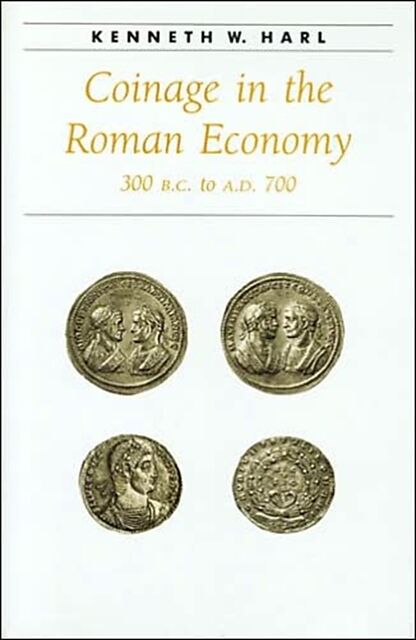Coinage in the Roman Economy, 300 B.C. to A.D. 700
Einband:
Fester Einband
EAN:
9780801852916
Untertitel:
Englisch
Genre:
Hobby & Haus
Autor:
Kenneth W. (Tulane University) Harl
Herausgeber:
Johns Hopkins University Press
Auflage:
New.
Anzahl Seiten:
472
Erscheinungsdatum:
06.09.1996
ISBN:
978-0-8018-5291-6
Informationen zum Autor Kenneth W. Harl, professor of history and Fellow of the American Numismatic Society, teaches classical and Byzantine history at Tulane University. He is the author of Civic Coins and Civic Politics in the Roman East, A.D. 180-275 . Klappentext The premier form of Roman money since the time of the Second Punic War (218-201 B.C.), coins were vital to the success of Roman state finances, taxation, markets, and commerce beyond the frontiers. Yet until now, the economic and social history of Rome has been written independently of numismatic studies, which detail such technical information as weight standards, mint output, hoards, and finds at archaeological sites. In Coinage in the Roman Economy, 300 B.C. to A.D. 700, noted classicist and numismatist Kenneth W. Harl brings together these two fields in the first comprehensive history of how Roman coins were minted and used. Drawing on both literary and documentary sources, as well as on current methods of metallurgical study and statistical analysis of coins from archaeological sites, Harl presents a sweeping overview of a system of coinage in use for more than a millennium. Challenging much recent scholarship, he emphasizes the important role played by coins during overseas expansion of the Roman Republic during the second century B.C., in imperial inflationary policies during the third and fourth centuries A.D., and in the dissolution of the Roman Mediterranean order in the seventh century A.D. He also offers the first region-by-region analysis of prices and wages throughout Roman history with reference to the changing buying power of the major circulating denominations. And he shows how the seldom studied provincial, civic, and imitative coinages were in fact important components of Roman currency. Richly illustrated with photographic reproductions of nearly three hundred specimens, Coinage in the Roman Economy offers a significant contribution to Roman economic history. It willbe of interest to scholars and students of classical antiquity and the Middle Ages as well as to professional and amateur numismatists. Zusammenfassung It will be of interest to scholars and students of classical antiquity and the Middle Ages! as well as to professional and amateur numismatists. ...
Autorentext
Kenneth W. Harl, professor of history and Fellow of the American Numismatic Society, teaches classical and Byzantine history at Tulane University. He is the author of Civic Coins and Civic Politics in the Roman East, A.D. 180-275.
Klappentext
The premier form of Roman money since the time of the Second Punic War (218-201 B.C.), coins were vital to the success of Roman state finances, taxation, markets, and commerce beyond the frontiers. Yet until now, the economic and social history of Rome has been written independently of numismatic studies, which detail such technical information as weight standards, mint output, hoards, and finds at archaeological sites. In Coinage in the Roman Economy, 300 B.C. to A.D. 700, noted classicist and numismatist Kenneth W. Harl brings together these two fields in the first comprehensive history of how Roman coins were minted and used. Drawing on both literary and documentary sources, as well as on current methods of metallurgical study and statistical analysis of coins from archaeological sites, Harl presents a sweeping overview of a system of coinage in use for more than a millennium. Challenging much recent scholarship, he emphasizes the important role played by coins during overseas expansion of the Roman Republic during the second century B.C., in imperial inflationary policies during the third and fourth centuries A.D., and in the dissolution of the Roman Mediterranean order in the seventh century A.D. He also offers the first region-by-region analysis of prices and wages throughout Roman history with reference to the changing buying power of the major circulating denominations. And he shows how the seldom studied provincial, civic, and imitative coinages were in fact important components of Roman currency. Richly illustrated with photographic reproductions of nearly three hundred specimens, Coinage in the Roman Economy offers a significant contribution to Roman economic history. It willbe of interest to scholars and students of classical antiquity and the Middle Ages as well as to professional and amateur numismatists.
Zusammenfassung
It will be of interest to scholars and students of classical antiquity and the Middle Ages, as well as to professional and amateur numismatists.

Leider konnten wir für diesen Artikel keine Preise ermitteln ...
billigbuch.ch sucht jetzt für Sie die besten Angebote ...
Die aktuellen Verkaufspreise von 6 Onlineshops werden in Realtime abgefragt.
Sie können das gewünschte Produkt anschliessend direkt beim Anbieter Ihrer Wahl bestellen.
Loading...
Die aktuellen Verkaufspreise von 6 Onlineshops werden in Realtime abgefragt.
Sie können das gewünschte Produkt anschliessend direkt beim Anbieter Ihrer Wahl bestellen.
| # | Onlineshop | Preis CHF | Versand CHF | Total CHF | ||
|---|---|---|---|---|---|---|
| 1 | Seller | 0.00 | 0.00 | 0.00 |
